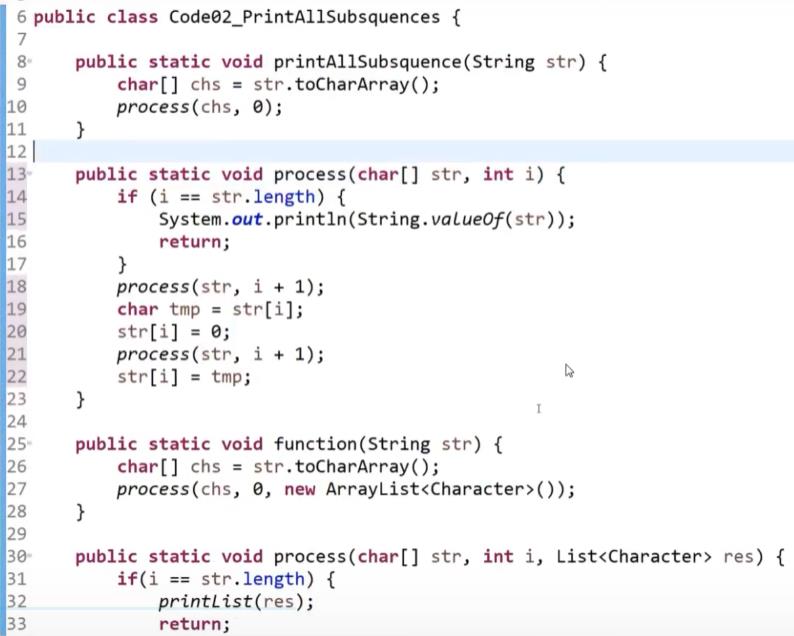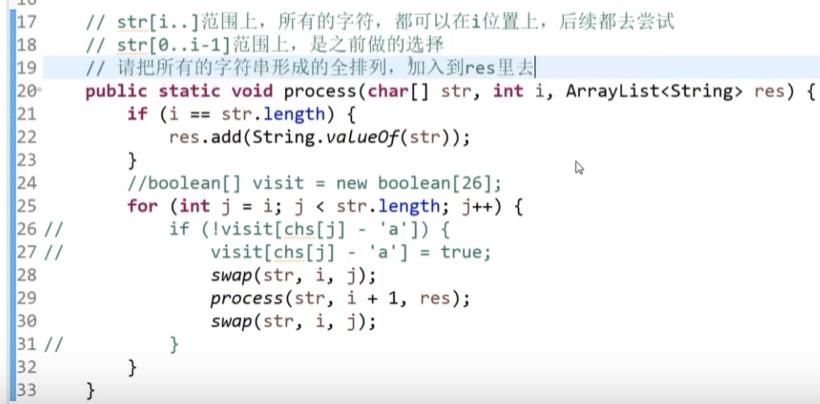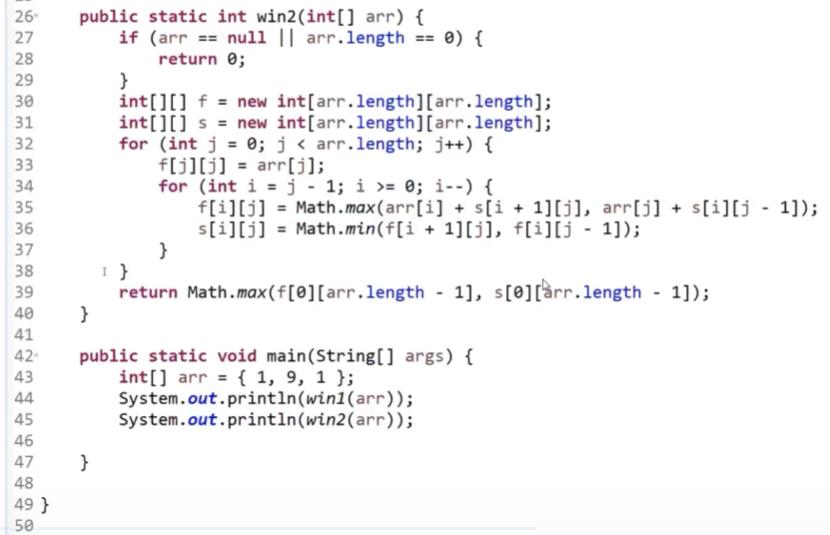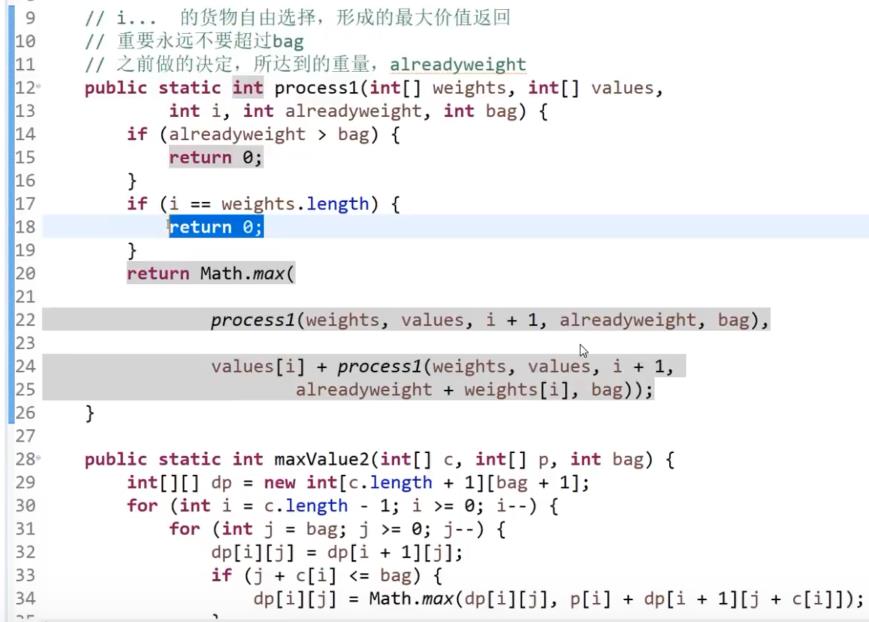dijkstra算法的堆加速和暴力递归算法
Posted 爱了爱了就离谱
tags:
篇首语:本文由小常识网(cha138.com)小编为大家整理,主要介绍了dijkstra算法的堆加速和暴力递归算法相关的知识,希望对你有一定的参考价值。
1、Dijkstra算法
#1、堆加速
不遍历。头节点更新完数组,将其他节点(出去无穷大和锁死节点)构成小根堆,选出值最小的(同时删掉)。更新节点的值,继续构成小根堆,选出值最小的(同时删掉),更新节点,循环。(小根堆的一个作用就是选最小的值,即堆顶。但是这里无法用系统提供的堆,需要自己写代码,因为系统无法更新确切节点的值并重新构成堆)
#2、代码
//改进后的dijkstra算法 //从head出发,所有能到达的节点,生成到达每个节点的最小路径记录并返回 public static HashMap<Node, Integer> dijkstra2(Node head, int size) { //返回哈希表 NodeHeap nodeHeap = new NodeHeap(size); //1443 nodeHeap.addOrUpdateOrIgnore(head, 0); HashMap<Node, Integer> result = new HashMap<>(); while (~nodeHeap.isEmpty()) { NodeRecord record = nodeHeap.pop(); Node cur = record.node; int distance = record.distance; for (Edge edge : cur.edges) { //堆顶后续的节点建立记录 nodeHeap.addOrUpdateOrIgnore(edge.to, edge.weight + distance); } result.put(cur, distance); //弹出堆顶就加记录 } return result; }
NodeHeap方法为:
public static class NodeHeap { private Node[] nodes; private HashMap<Node, Integer> heapIndexMap; //用来查node在堆上的位置 private HashMap<Node, Integer> distanceMap; //当前最小距离表 private int size; public NodeHeap(int size) { nodes = new Node[size]; heapIndexMap = new HashMap<>(); distanceMap = new HashMap<>(); this.size = 0; public boolean isEmpty() { return size == 0; } public void addOrUpdateOrIgnore(Node node, int distance) { if (inHeap(node)) { //如果在堆上 distanceMap.put(node, Math.min(distanceMap.get(node), distance)); insertHeapify(node, heapIndexMap.get(node)); } if (!isEntered(node)) { //如果节点未进过堆 nodes[size] = node; heapIndexMap.put(node, distance); insertHeapify(node, size++); } //进来过但是现在不在堆上,忽略 } public NodeRecord pop() { NodeRecord nodeRecord = new NodeRecord(nodes[0], distanceMap.get(nodes[0])); swap(0, size - 1); //最后一个元素在堆顶 heapIndexMap.put(nodes[size - 1], -1); distanceMap.remove(nodes[size - 1]); nodes[size - 1] = null; //C++需要free() heapify(0, --size); return nodeRecord; } private void insertHeapify(Node node, int index) { while (distanceMap.get(nodes[index]) < distanceMap.get(nodes[(index-1)/2]; swap(index, (index-1)/2); index = (index - 1)/2; } } private void heapify(int index, int size) { int left = index*2 + 1; while (left < size) { int smallest = left + 1 < size && distanceMap.get(nodes[left + 1]) < distance /*/缺失一部分*/ ? left + 1 : left; smallest = distanceMap.get(nodes[smallest]) < distanceMap.get(nodes[index /*缺失*/ if (smallest == index) { break; } swap(smallest, index); index = smallest; left = index*2 + 1; } } private boolean isEntered(Node node) { //node是否进过堆 return heapIndexMap.containsKey(node); } private boolean inHeap(Node node) { //node进过堆标记为-1(现在不在堆) reeturn isEntered(node) && heapIndexMap.get(node) != -1; } private void swap(int index1, int index2) { //在堆上的node交换,map和堆都交换 heapIndexMap.put(nodes[index1], index2); heapIndexMap.put(nodes[index2], index1); Node tmp = nodes[index1]; nodes[index1] = nodes[index2]; nodes[index2] = tmp; } }
2、暴力递归(就是尝试)
#1、暴力递归
1.把问题转化为规模缩小了的同类问题的子问题
2.有明确的不需要继续进行递归的条件(base case)
3.有得到子问题的结果之后的决策过程
4.不记录每一个子问题的解
一定要学会怎么去尝试,因为这是动态规划的基础。
(1)汉诺塔问题
#1、典型形式:三根杆子,三个大小不等圆盘(大的不能压小的),移动三个圆盘。
#2、抽象:有start,end,other,把1~i-1个圆盘移动到other,第 i 个据能到to上了。代码见下:
package class08; public class Code01_Hanoi { public static void hanoi(int n) { if (n > 0) { func(n, "左", "右", "中"); } } public static void func(int i, String start, String end, String other) { if (i == 1) { //base case System.out.println("Moce 1 from " + start + " to " + end); } else { func(i - 1, start, other, end); System.out.println("Move " + i + " from " + start + " to " + end); func(i - 1, other, end, start); } } public static void main(String[] args) { int n = 3; hanoi(n); } }
(2)打印字符串问题
#1、打印一个字符串的全部子序列包括空串
1.其实就是指向任意一个字符时都可以选择要或者不要。代码见下(看第二幅里的方法就行)


#2、打印一个字符串的全部排列
1.取出单个字符进行排列(加上注释的部分就是下面不重复的代码)

#3、打印一个字符串的全部排列且不出现重复的排列
1.可以利用上面去掉注释的代码(这一部分居然也称为剪枝),也可以对上面的结果清除重复(慢一些)。
(3)博弈论-取纸牌问题
#1、懒了,直接粘贴题目吧:

#2、分析
1.先手的情况 int f (arr, L, R)尝试所有的可能:
//伪代码 int f(arr, L, R) if (L == R) retuurn arr[L] max {arr[L] + s(arr, L + 1,R), arr[R] + s(arr, L, R-1) } //s为后手函数 int s(arr, L, R) L == R return 0; min{ f(arr, L + 1, R), f(arr, L, R - 1) } //注意这里是min,因为它由对方决定


(4)给一个栈,逆序这个栈,不能申请额外的数据结构,只能使用递归函数,如何实现?
#1、思想:
1.先定义一个函数,它实现移除栈底元素并返回。
public static int f(Stack<<Integer> stack) { //栈进入f int result = stack.pop(); //弹出一个变量到临时变量result if (stack.isEmpty()) { return result; } else { int last = f(stack); //其实弹出第二个 又调用原来的f stack.push(result); return last; } }
2.逆序
package class08; import java.util.Stack; public class Code04_ReverseStackUsingRecursive { public static void reverse(Stack<Integer> stack) { if (stack.isEmpty()) { return; } int i = f(stack); //出来最后一个 reverse(stack); stack.push(i); //压回去 } public static int f(Stack<Integer> stack) { //见上文 //... public static void main(String[] args) { Stack<Integer> test = new Stack<Integer>(); test.push(1); test.push(2); test.push(3); reverse(test); while (!test.isEmpty()) { System.ou.println(test.pop()); } } }
(5)规定1和A对应,2和B对应,3和C对应...那么数字字符串可以转化为字母字符串,给定一个只有数字字符组成的字符串str,返回有多少种转化结果(注意,有多种解读方案,如111可解读为AAA、KA等)。
#1、利用数学归纳思想,不管前面的 i 个(假设已经确定),那么当前只考虑编号 i 的译码方式。
1. i 位置的值为0,那么根本译码不下去,return 0;
2. i 的值不是零而是1或者2,那么可能转换 i 本身或者 i, i+1一起转换。(其实还可以分,如果i是2,i+1 可以分为 0~6和7~9)
3. i 位置的值是 3~9 ,只能译码自己。
#2、代码实现
package class08; public class Code06_ConvertToLetterString {
public static int number(String str) {
if (str == null || str.length() == 0) { return 0; } return process(str.toCharArray(),0);
} //i 位置之前如何转化是确定的 public static int process(char[] chs, int i) { if (i == chs.length) { return 1; } if ( chs[i] == \'0\') { return 0; } if (chs[i] == \'1\') { int res = process(chs, i + 1); //i 自己作为独立部分 if (i + 1 < chs.length) { res += process(chs, i + 2); // i 和 i+1构成整体 } return res; } if (chs[i] == \'2\') { int res = process(chs, i + 1); if (i + 1 < chs.length && (chs[i + 1] >= \'0\' && chs[i + 1] <= \'6\')) { res += process(chs, i + 2); } return res; } return process(chs, i+1); //实际上是 i 为三到九的情况 } public static void main(String[] args) { System.out.println(number("1111233498")); } }
(6)给定两个长度都为N的数组weights和values,weights[i] 和 values[i] 分别代表 i 号 物品的质量和价值。给定一个正数bag表示载重,返回能装下的物品的最大价值。
#1、暴力算法就是每遇到一个选择要或者不要(可变参数越少越好,便于改成动态规划问题)

以上是关于dijkstra算法的堆加速和暴力递归算法的主要内容,如果未能解决你的问题,请参考以下文章